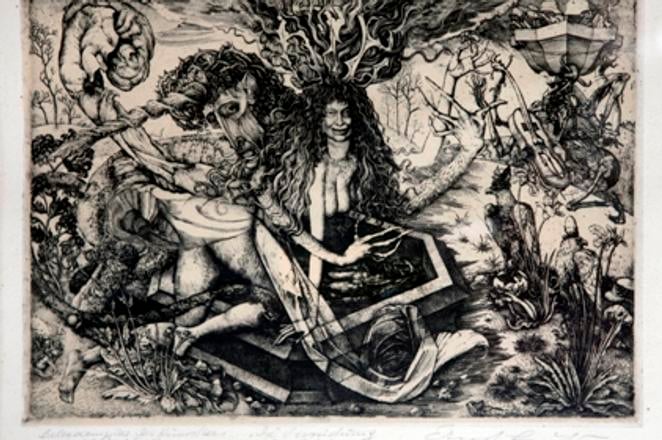FUCHS means “fox” in English, and those who have met the famous Austrian artist Ernst Fuchs in person would describe him as “artful, accomplished and a clever fox”. Yet, Fuchs, a true Renaissance man, can also be called a graphic artist, painter, sculptor, designer, architect, writer, stage designer, poet and more, as well as a founder of a strain of Austrian art known as Fantastic Realism.
The Bratislava City Gallery (GMB) is exhibiting a retrospective of his work this summer, in the reconstructed Pálffy Palace in downtown Bratislava.
Born in Vienna in 1930, Fuchs had to study at home (his father was Jewish and had to emigrate in 1938), as he was denied a regular school education. At the early age of 15, Fuchs was encouraged to study painting and sculpting, and after 1945, he studied at the Academy of Fine Arts in Vienna. He helped found the Vienna School of Fantastic Realism, influenced mainly by Christian and Jewish mystics and the pain caused by the Second World War. His Expressionist-inspired charcoal drawings earned him a good reputation in Vienna in the 1940s.
In 1945, he followed his friend Friedrich Hundertwasser to Paris, where he started painting miniatures in the style of old masters. There, he met Salvador Dali, who praised his work and called him the “German Dali”. Later, Fuchs travelled to the US, where he inspired the airbrush and fantasy painting art movements of the 1950s, the GMB writes in its leaflet.
In 1972, Fuchs managed to acquire the derelict villa of architect Otto Wagner in Vienna and after reconstructing it, he started fulfilling his dreams there by painting monumental versions of his earlier drawings and engravings. He continued this later.
The Bratislava exhibition is unique in that it places his earlier, more intimate and delicate works alongside the later bigger paintings. His cycle Unicorn is exhibited here in its entirety for the very first time.
“I often have the impression that I am only now starting to discover what I always wanted to do and never could,” Fuchs told The Slovak Spectator when asked about his feelings at the exhibition’s opening. “The projects that I have always desired to make are coming true only now. That is a nice experience.”
When asked to compare his earlier and later work, Fuchs answered that he believes in reincarnation and that God does not want people to understand every-thing at once. “He wants us to be challenged, stimulated, to keep learning.”
The exhibition of Fuchs, called Retrospective, is comprised of many different works spanning many genres from his nearly 70-year career. It is the first Fuchs’ exhibition of this size in Slovakia, GMB head Ivan Jančár said. It can be seen until September 21 daily, except for Mondays (between 11:00-18:00), in the Pálffy Palace on Panská Street in Bratislava.



 Ernst Fuchs: Die Versuchung des Einhorns / The Temptaiton of a Unicorn, 1952 (source: Courtesy of GMB)
Ernst Fuchs: Die Versuchung des Einhorns / The Temptaiton of a Unicorn, 1952 (source: Courtesy of GMB)